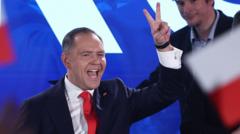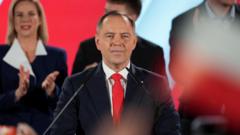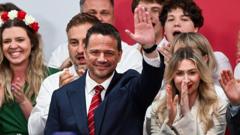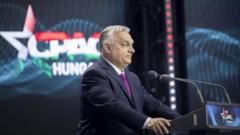With Rafal Trzaskowski narrowly leading, the nation holds its breath for the official results, signaling a deeper political narrative at play.
**Poland's Presidential Race: A Neck-and-Neck Contest**

**Poland's Presidential Race: A Neck-and-Neck Contest**
As Poland's presidential runoff election unfolds, exit polls reveal a tight race, testing the limits of populism in Europe.
In a nail-biting presidential election in Poland on Sunday, the race between the two main candidates has reached a critical juncture, with exit polls indicating a virtually tied outcome as the day concluded and the official ballot counting commenced. Rafal Trzaskowski, the liberal mayor of Warsaw, claimed a slight edge in what has become a defining moment for the country's political landscape, projected to bring profound implications for the future of governance in Poland.
Mr. Trzaskowski confidently declared, “Dear ladies and gentlemen — we won!” to his gathered supporters, emphasizing the historic nature of the close race. Preliminary figures from exit polling revealed him with a marginal advantage of 50.3 percent, compared to 49.7 percent for his rival, Karol Nawrocki, a historian endorsed by the nationalist Law and Justice party, which had previously dominated Polish politics.
In response, Nawrocki rallied his own backers by expressing his conviction in an eventual victory: “Dear people, we will win. Tonight we will win and save Poland.” The election saw a robust turnout of 72.8 percent, the highest since the landmark vote in 1990 that ushered in democracy following the Communist regime's collapse.
This election not only serves as an internal gauge of Polish politics, but it is also viewed as a broader commentary on the current popularity of populist nationalism, drawing comparisons to recent political trends across Europe and the United States. The campaign saw influencers from both sides of the Atlantic, including figures supporting former President Trump, backing Mr. Nawrocki, while central European political powers leaned toward Mr. Trzaskowski.
The outcomes hinge on whether Polish voters are inclined to elect a president who can collaborate with the centrist government led by Prime Minister Donald Tusk or one who stands in opposition. The tight results showcase the stark divides in Polish society, split between a hard-right nationalist faction and a centrist coalition supporting democratic reforms.
Should Mr. Trzaskowski emerge victorious, it could herald the closure of a prolonged period of legislative standoff that arose after a 2023 election left the Law and Justice party without a parliamentary majority. Conversely, a win for Mr. Nawrocki may solidify an ongoing impasse, affecting the balance of power within the Polish government.
The official results, expected to be announced on Monday, could reshape the political landscape in Poland for years to come, marking a pivotal moment in the ongoing saga of European politics.
Mr. Trzaskowski confidently declared, “Dear ladies and gentlemen — we won!” to his gathered supporters, emphasizing the historic nature of the close race. Preliminary figures from exit polling revealed him with a marginal advantage of 50.3 percent, compared to 49.7 percent for his rival, Karol Nawrocki, a historian endorsed by the nationalist Law and Justice party, which had previously dominated Polish politics.
In response, Nawrocki rallied his own backers by expressing his conviction in an eventual victory: “Dear people, we will win. Tonight we will win and save Poland.” The election saw a robust turnout of 72.8 percent, the highest since the landmark vote in 1990 that ushered in democracy following the Communist regime's collapse.
This election not only serves as an internal gauge of Polish politics, but it is also viewed as a broader commentary on the current popularity of populist nationalism, drawing comparisons to recent political trends across Europe and the United States. The campaign saw influencers from both sides of the Atlantic, including figures supporting former President Trump, backing Mr. Nawrocki, while central European political powers leaned toward Mr. Trzaskowski.
The outcomes hinge on whether Polish voters are inclined to elect a president who can collaborate with the centrist government led by Prime Minister Donald Tusk or one who stands in opposition. The tight results showcase the stark divides in Polish society, split between a hard-right nationalist faction and a centrist coalition supporting democratic reforms.
Should Mr. Trzaskowski emerge victorious, it could herald the closure of a prolonged period of legislative standoff that arose after a 2023 election left the Law and Justice party without a parliamentary majority. Conversely, a win for Mr. Nawrocki may solidify an ongoing impasse, affecting the balance of power within the Polish government.
The official results, expected to be announced on Monday, could reshape the political landscape in Poland for years to come, marking a pivotal moment in the ongoing saga of European politics.





















